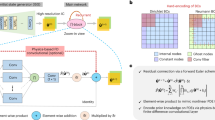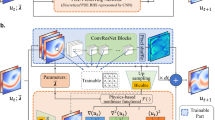Abstract
Exit events induced by noise from the attracting domain containing a stable fixed point are ubiquitous phenomena in physical systems, wherein mean exit time is an important quantity which has been widely used in engineering, physical, chemical and biological fields. In this work, we devise a deep learning method to compute the mean exit time for dynamical systems excited by weak Gaussian noise. More specifically, we first derive a complete group of ordinary differential equations governing the most probable path, the quasipotential, and the prefactor along the path via WKB approximation. Then a neural network architechture is proposed to solve it in terms of automatic differentiation. The results of numerical experiments show the effectiveness and accuracy of the algorithm and imply its potential applications to discover the mechanisms of rare events triggered by random fluctuations in practical models.














Similar content being viewed by others
Data availability
The data that support the findings of this study are available from the corresponding author upon reasonable request.
References
Grafke, T., Vanden-Eijnden, E.: Numerical computation of rare events via large deviation theory. Chaos 29(6), 063118 (2019)
Freidlin, M.I., Wentzell, A.D.: Random Perturbations of Dynamical Systems. Springer, Berlin (2012)
Mutothya, N.M., Xu, Y.: Mean first passage time for diffuse and rest search in a confined spherical domain. Phys. A Stat. Mech. Appl. 567, 125667 (2021)
Zhu, W., Wu, Y.: First-passage time of duffing oscillator under combined harmonic and white-noise excitations. Nonlinear Dyn. 32(3), 291–305 (2003)
Bressloff, P.C., Newby, J.M.: Metastability in a stochastic neural network modeled as a velocity jump Markov process. SIAM J. Appl. Dyn. Syst. 12(3), 1394–1435 (2013)
Khovanov, I., Polovinkin, A., Luchinsky, D., McClintock, P.: Noise-induced escape in an excitable system. Phys. Rev. E 87(3), 032116 (2013)
Matkowsky, B., Schuss, Z.: Diffusion across characteristic boundaries. SIAM J. Appl. Math. 42(4), 822–834 (1982)
Matkowsky, B., Schuss, Z., Tier, C.: Diffusion across characteristic boundaries with critical points. SIAM J. Appl. Math. 43(4), 673–695 (1983)
Naeh, T., Kłosek, M., Matkowsky, B., Schuss, Z.: A direct approach to the exit problem. SIAM J. Appl. Math. 50(2), 595–627 (1990)
Maier, R.S., Stein, D.L.: Limiting exit location distributions in the stochastic exit problem. SIAM J. Appl. Math. 57(3), 752–790 (1997)
Allen, R.J., Frenkel, D., ten Wolde, P.R.: Simulating rare events in equilibrium or nonequilibrium stochastic systems. J. Chem. Phys 124(2), 48913 (2006)
Heymann, M., Vanden-Eijnden, E.: The geometric minimum action method: A least action principle on the space of curves. Commun. Pure Appl. Math. 61(8), 1052–1117 (2008)
Lindley, B.S., Schwartz, I.B.: An iterative action minimizing method for computing optimal paths in stochastic dynamical systems. Phys. D Nonlinear Phenom. 255, 22–30 (2013)
Zhou, X., Ren, W.: Adaptive minimum action method for the study of rare events. J. Chem. Phys. 128(10), 104111 (2008)
Cameron, M.: Finding the quasipotential for nongradient SDEs. Phys. D Nonlinear Phenom. 241(18), 1532–1550 (2012)
Dahiya, D., Cameron, M.: Ordered line integral methods for computing the quasi-potential. J. Sci. Comput. 75(3), 1351–1384 (2018)
Brunton, S.L., Kutz, J.N.: Data-driven Science and Engineering: Machine Learning, Dynamical Systems, and Control. Cambridge University Press, Cambridge (2022)
Weinan, E.: A proposal on machine learning via dynamical systems. Commun. Math. Stat. 1(5), 1–11 (2017)
Chen, X., Yang, L., Duan, J., Karniadakis, G.E.: Solving inverse stochastic problems from discrete particle observations using the Fokker-Planck equation and physics-informed neural networks. SIAM J. Sci. Comput. 43(3), B811–B830 (2021)
Li, Y., Duan, J.: A data-driven approach for discovering stochastic dynamical systems with non-Gaussian Lévy noise. Phys. D Nonlinear Phenom. 417, 132830 (2021)
Li, Y., Duan, J.: Extracting governing laws from sample path data of non-Gaussian stochastic dynamical systems. J. Stat. Phys. 186(2), 30 (2022)
Zhang, Z., Shin, Y., Em Karniadakis, G.: Gfinns: Generic formalism informed neural networks for deterministic and stochastic dynamical systems. Philos. Trans. R. Soc. A 380(2229), 20210207 (2022)
Xu, Y., Zhang, H., Li, Y., Zhou, K., Liu, Q., Kurths, J.: Solving Fokker-Planck equation using deep learning. Chaos 30(1), 013133 (2020)
Zhang, H., Xu, Y., Liu, Q., Wang, X., Li, Y.: Solving Fokker-Planck equations using deep kd-tree with a small amount of data. Nonlinear Dyn. 108(4), 4029–4043 (2022)
Yeo, K., Melnyk, I.: Deep learning algorithm for data-driven simulation of noisy dynamical system. J. Comput. Phys. 376, 1212–1231 (2019)
Li, Y., Duan, J., Liu, X.: Machine learning framework for computing the most probable paths of stochastic dynamical systems. Phys. Rev. E 103(1), 012124 (2021)
Wei, W., Gao, T., Chen, X., Duan, J.: An optimal control method to compute the most likely transition path for stochastic dynamical systems with jumps. Chaos 32(5), 051102 (2022)
Li, Y., Xu, S., Duan, J., Liu, X., Chu, Y.: A machine learning method for computing quasi-potential of stochastic dynamical systems. Nonlinear Dyn. 109(3), 1877–1886 (2022)
Lin, B., Li, Q., Ren, W.: A data driven method for computing quasipotentials. In Mathematical and Scientific Machine Learning, pp. 652–670. PMLR, (2022)
Raissi, M., Perdikaris, P., Karniadakis, G.: Physics-informed neural networks: A deep learning framework for solving forward and inverse problems involving nonlinear partial differential equations. J. Comput. Phys. 378, 686–707 (2019)
Jin, X., Cai, S., Li, H., Karniadakis, G.E.: Nsfnets (navier-stokes flow nets): Physics-informed neural networks for the incompressible navier-stokes equations. J. Comput. Phys. 426, 109951 (2021)
Pang, G., Lu, L., Karniadakis, G.E.: fpinns: Fractional physics-informed neural networks. SIAM J. Sci. Comput. 41(4), A2603–A2626 (2019)
Yuan, L., Ni, Y.-Q., Deng, X.-Y., Hao, S.: A-pinn: Auxiliary physics informed neural networks for forward and inverse problems of nonlinear integro-differential equations. J. Comput. Phys. 462, 111260 (2022)
O’Leary, J., Paulson, J.A., Mesbah, A.: Stochastic physics-informed neural ordinary differential equations. J. Comput. Phys. 468, 111466 (2022)
Liu, D., Wang, Y.: Multi-fidelity physics-constrained neural network and its application in materials modeling. J. Mech. Design 141(12), 121403 (2019)
Kharazmi, E., Zhang, Z., Karniadakis, G.E.: hp-vpinns: Variational physics-informed neural networks with domain decomposition. Comput. Methods Appl. Mech. Eng. 374, 113547 (2021)
Jagtap, A.D., Kharazmi, E., Karniadakis, G.E.: Conservative physics-informed neural networks on discrete domains for conservation laws: Applications to forward and inverse problems. Comput. Methods Appl. Mech. Eng. 365, 113028 (2020)
Beri, S., Mannella, R., Luchinsky, D.G., Silchenko, A., McClintock, P.V.: Solution of the boundary value problem for optimal escape in continuous stochastic systems and maps. Phys. Rev. E 72(3), 036131 (2005)
Duan, J.: An Introduction to Stochastic Dynamics. Cambridge University Press, New York (2015)
Roy, R.V.: Asymptotic analysis of first-passage problems. Int. J. Nonlinear Mech. 32(1), 173–186 (1997)
Maier, R.S., Stein, D.L.: A scaling theory of bifurcations in the symmetric weak-noise escape problem. J. Stat. Phys. 83(3), 291–357 (1996)
Keller, Herbert B.: Num. Methods Two Point Bound. Value Problems. Blaisdell Publishing Company, Waltham (1968)
Wang, F.: Bifurcations of nonlinear normal modes via the configuration domain and the time domain shooting methods. Commun. Nonlinear Sci. Num. Simul. 20(2), 614–628 (2015)
Funding
The authors acknowledge support from the National Natural Science Foundation of China (Grant Nos. 12302035, 62073166, 62221004), the Natural Science Foundation of Jiangsu Province (Grant No. BK20220917), the Key Laboratory of Jiangsu Province, the Shandong Provincial Natural Science Foundation under Grant ZR2021ZD13, and the Project on the Technological Leading Talent Teams Led by Frontiers Science Center for Complex Equipment System Dynamics (FSCCESD220401).
Author information
Authors and Affiliations
Corresponding author
Ethics declarations
Conflict of interest
The authors declare that they have no conflict of interest.
Additional information
Publisher's Note
Springer Nature remains neutral with regard to jurisdictional claims in published maps and institutional affiliations.
Rights and permissions
Springer Nature or its licensor (e.g. a society or other partner) holds exclusive rights to this article under a publishing agreement with the author(s) or other rightsholder(s); author self-archiving of the accepted manuscript version of this article is solely governed by the terms of such publishing agreement and applicable law.
About this article
Cite this article
Li, Y., Zhao, F., Xu, S. et al. A deep learning method for computing mean exit time excited by weak Gaussian noise. Nonlinear Dyn 112, 5541–5554 (2024). https://doi.org/10.1007/s11071-024-09280-w
Received:
Accepted:
Published:
Issue Date:
DOI: https://doi.org/10.1007/s11071-024-09280-w




